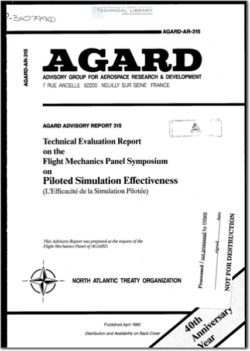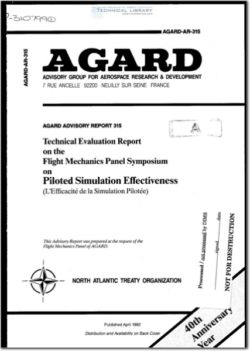AGARD-AR-315

- Version
- 197 Downloads
- 963.54 KB File Size
- 1 File Count
- March 8, 2016 Create Date
- March 8, 2016 Last Updated
Piloted Simulation Effectiveness

From a minor role in aircraft design, development and clearance in the 1950's, flight simulation now has an
established part to play. A further and vital contribution to aerospace lies in the use of simulation for
crew training in almost all operational tasks. The contribution that flight simulation can make in these
areas continues to increase, as the elements used in simulation improve. These improvements stem from
developments in non-aerospace activities, such as communications and entertainment, which fund advances in
graphics and display technology beyond the resources of flight simulation alone. Similarly, general advances
in computing technology meet the need for complex modelling and real-time processing.
In a rapid1y changing discipline such as flight simulation, it is important that advances are accessible to
workers in the field. AGARD provides the ideal forum for this process, in the form of Symposia and published
documents such as Conference Proceedings. The Flight Mechanics Panel devotes a Symposium to Flight Simulation
approximately every six years, at which time, new developments can be aired. Because of the rapid progress
and the broad scope (even when confined to military applications), the theme for the symposium has to be
chosen with care. Should it focus on the technology used to design simulators, or on the facilities to meet
users' needs, or on the experiences of operators?. The need for a meeting on Flight Simulation was also
appropriate because of the changes which have come to Aerospace since the last meeting in Cambridge in 1986;
changes which are having a serious effect in all areas of simulation. World economic recession, political
changes in Eastern Europe, and the Middle East conflict have had a profound influence on short term
prospects, Research budgets have been cut, Industry is contracting, and the financial pressures on all
projects is intense.
It is appropriate, therefore, that the FM? chose as a theme for this meeting "Piloted Simulation
Effectiveness". The intent of the Symposium was "to provide information on the benefits and potential that
the many elements of simulation technology have to meet the different task requirements during Conceptual
R&D, aircraft development, skill training, and full mission training. The scope includes both fixed wing and
rotary wing aircraft, and their systems." Particularly welcome were papers in which simulated and real tasks
were compared, and methods of measuring effectiveness were identified.Also sought was a Keynote address “to
give a realistic view of the current capability and shortcomings, and also the future potential of
simulation", to be given by a user, rather than a provider, of simulation.
| File | Action |
|---|---|
| AGARD-AR-315 Piloted Simulation Effectiveness.pdf | Download |

Comment On This Post